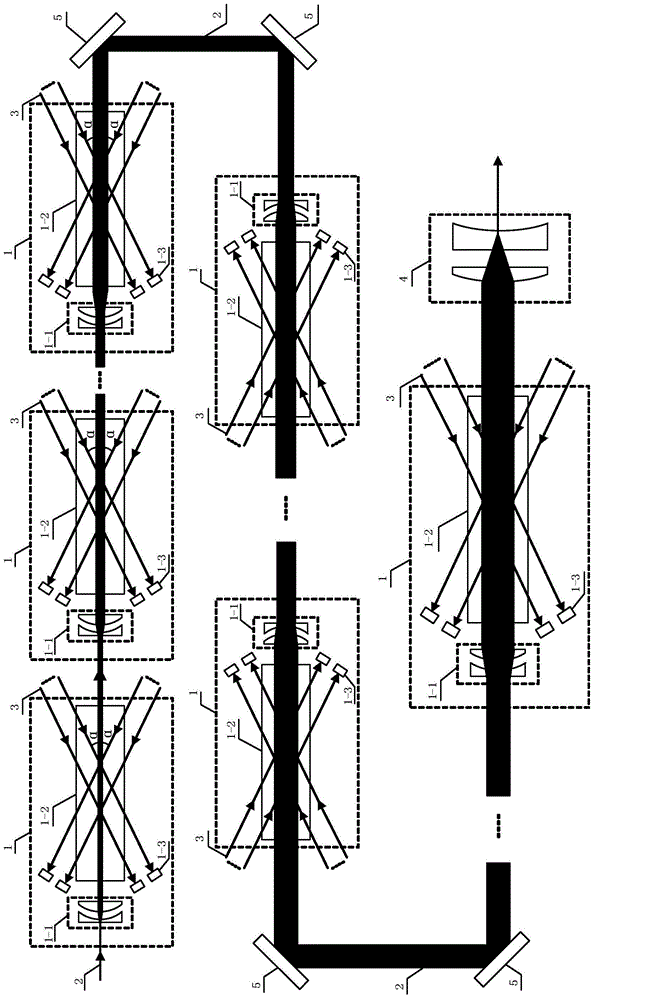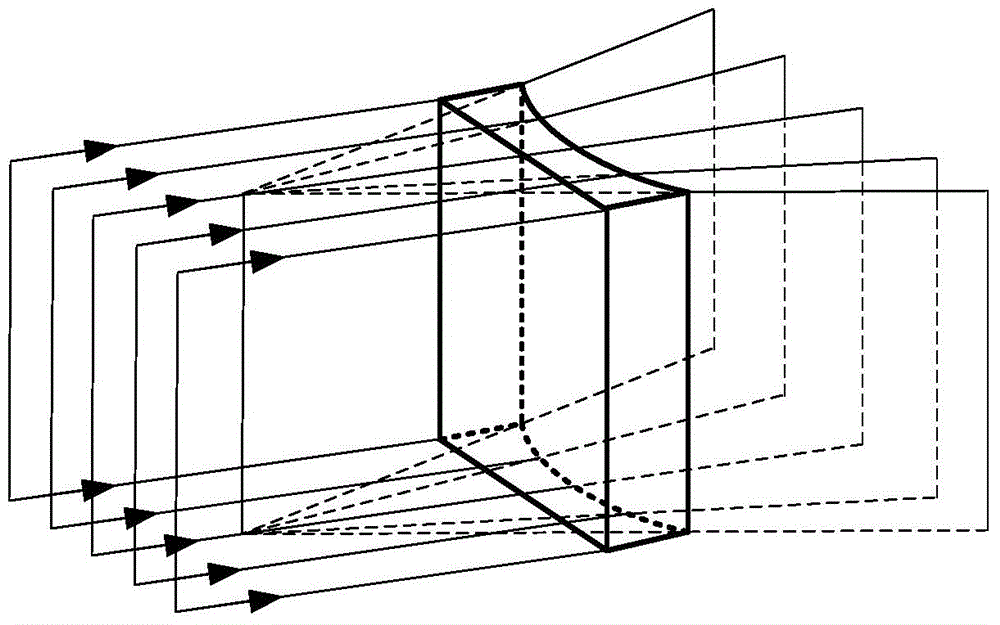Non-collineation serial beam grouping method and device based on excited brillouin scattering
A stimulated Brillouin, non-collinear technology, applied in the field of optics, can solve the problem of not being able to further realize beam grouping, and achieve the effect of low energy stability requirements, simple structure, and improved volume of action
- Summary
- Abstract
- Description
- Claims
- Application Information
AI Technical Summary
Problems solved by technology
Method used
Image
Examples
specific Embodiment approach 1
[0016] Specific implementation mode 1: Combination figure 1 To illustrate this embodiment, the non-collinear serial beam combining method based on stimulated Brillouin scattering described in this embodiment is: a cylindrical surface is provided at the seed light incident end of each non-collinear Brillouin amplification structure unit 1 Lens expansion system 1-1, the seed light 2 is expanded by the cylindrical lens beam expansion system 1-1, and then enters the non-collinear Brillouin amplification structure unit 1, multiple non-collinear Brillouin amplification structure units 1Serial connection.
[0017] In the above method, before the seed light 2 enters each dielectric cell 1-2, it is expanded by the cylindrical lens beam expanding system 1-1. This method can improve the load capacity of the beam assembly device and avoid stimulated Raman scattering. Non-linear effects and dielectric breakdown threshold problems.
specific Embodiment approach 2
[0018] Specific implementation manner two: combination figure 1 This embodiment is described. This embodiment is a further limitation to the non-collinear serial beam combining method based on stimulated Brillouin scattering described in the first embodiment. In this embodiment, the non-collinear Brillouin A cylindrical lens beam reduction system 4 is provided at the seed light output end of the louver magnification structure unit 1, and the seed light 2 is amplified by the last-stage non-collinear Brillouin magnification structure unit 1, and then exits through the cylindrical lens beam reduction system 4.
[0019] The cylindrical lens beam reduction system 4 is used to shape the seed light 2 into the shape before magnification. After several levels of beam combination, the beam spot shape of the output amplified light can still be kept the same as before the incident.
specific Embodiment approach 3
[0020] Specific implementation mode three: combination figure 1 To illustrate this embodiment, the non-collinear serial beam combining device based on stimulated Brillouin scattering in this embodiment includes n non-collinear Brillouin amplification structural units 1, where n is a natural number, and n> 1. The n non-collinear Brillouin magnifying structure units 1 are connected in series, and each non-collinear Brillouin magnifying structure unit 1 includes a cylindrical lens beam expanding system 1-1, a dielectric cell 1-2 and an optical trap 1 -3. After the seed light 2 is expanded by the cylindrical lens beam expanding system 1-1, it is incident into the medium cell 1-2 along the length of the medium cell 1-2, and the pump light 3 is from one of the medium cell 1-2 The side is incident into the medium cell 1-2 and the seed light 2 is amplified. The remaining pump light 3 passes through the medium cell 1-2 and then enters the optical trap 1-3. The seed light 2 and the pump li...
PUM
| Property | Measurement | Unit |
|---|---|---|
| Angle of incidence | aaaaa | aaaaa |
Abstract
Description
Claims
Application Information
 Login to View More
Login to View More - R&D
- Intellectual Property
- Life Sciences
- Materials
- Tech Scout
- Unparalleled Data Quality
- Higher Quality Content
- 60% Fewer Hallucinations
Browse by: Latest US Patents, China's latest patents, Technical Efficacy Thesaurus, Application Domain, Technology Topic, Popular Technical Reports.
© 2025 PatSnap. All rights reserved.Legal|Privacy policy|Modern Slavery Act Transparency Statement|Sitemap|About US| Contact US: help@patsnap.com



